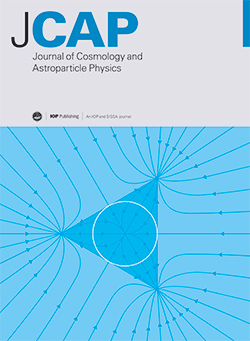张量标量诱导的GWs能主导PTA观测吗?
IF 5.3
2区 物理与天体物理
Q1 ASTRONOMY & ASTROPHYSICS
Journal of Cosmology and Astroparticle Physics
Pub Date : 2025-03-21
DOI:10.1088/1475-7516/2025/03/045
引用次数: 0
摘要
对小尺度原始引力波的观测约束要比大尺度的弱得多。我们将重点放在具有显著原始引力波和小尺度曲率扰动的场景上,研究二阶张量-尺度诱导引力波(TSIGW)的能量密度谱。通过利用当前的宇宙微波背景(CMB)、重子声振荡(BAO)和脉冲星定时阵列(PTA)数据,结合激光干涉仪空间天线(LISA)的信噪比(SNR)分析,我们可以研究张量-尺度诱导引力波如何影响不同尺度上的观测,从而约束原始引力波和曲率扰动的参数空间。贝叶斯因子分析表明,与超大质量黑洞双星(SMBHB)相比,张量-尺度诱导引力波(TSIGW)+原始引力波(PGW)可能更有可能主导当前的脉冲星定时阵列(PTA)观测。本文章由计算机程序翻译,如有差异,请以英文原文为准。
Can tensor-scalar induced GWs dominate PTA observations?
Observational constraints on small-scale primordial gravitational waves are considerably weaker than those on large scales. We focus on scenarios with significant primordial gravitational waves and curvature perturbations on small scales, studying the energy density spectrum of the second-order tensor-scalar induced gravitational wave (TSIGW). By leveraging current data from cosmic microwave background (CMB), baryon acoustic oscillations (BAO), and pulsar timing array (PTA), combined with the signal-to-noise ratio (SNR) analysis of Laser Interferometer Space Antenna (LISA), we can investigate how tensor-scalar induced gravitational waves affect observations on various scales, thus constraining the parameter space for primordial gravitational waves and curvature perturbations. The Bayes factor analysis suggests that tensor-scalar induced gravitational wave (TSIGW)+primordial gravitational wave (PGW) might be more likely to dominate current pulsar timing array (PTA) observations compared to supermassive black hole binary (SMBHB).
求助全文
通过发布文献求助,成功后即可免费获取论文全文。
去求助
来源期刊

Journal of Cosmology and Astroparticle Physics
地学天文-天文与天体物理
CiteScore
10.20
自引率
23.40%
发文量
632
审稿时长
1 months
期刊介绍:
Journal of Cosmology and Astroparticle Physics (JCAP) encompasses theoretical, observational and experimental areas as well as computation and simulation. The journal covers the latest developments in the theory of all fundamental interactions and their cosmological implications (e.g. M-theory and cosmology, brane cosmology). JCAP''s coverage also includes topics such as formation, dynamics and clustering of galaxies, pre-galactic star formation, x-ray astronomy, radio astronomy, gravitational lensing, active galactic nuclei, intergalactic and interstellar matter.
 求助内容:
求助内容: 应助结果提醒方式:
应助结果提醒方式:


